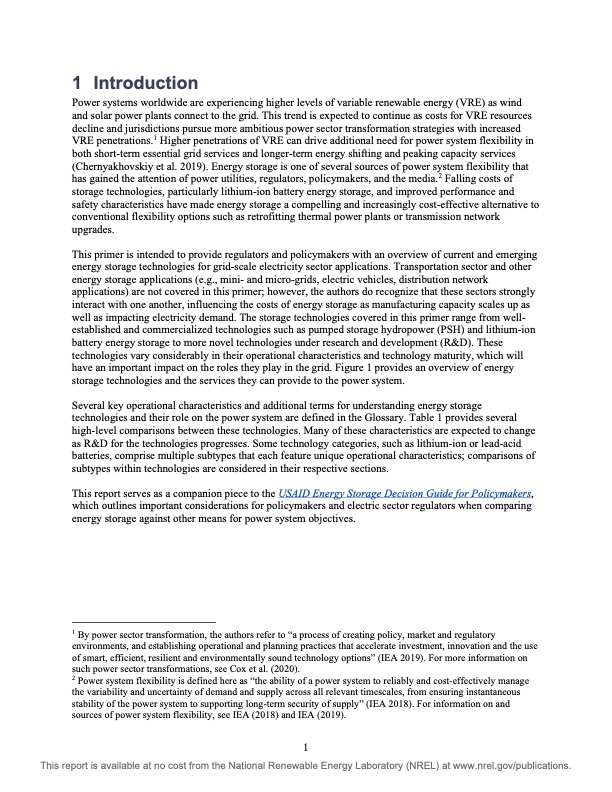
PDF Publication Title:
Text from PDF Page: 008
1 Introduction Power systems worldwide are experiencing higher levels of variable renewable energy (VRE) as wind and solar power plants connect to the grid. This trend is expected to continue as costs for VRE resources decline and jurisdictions pursue more ambitious power sector transformation strategies with increased VRE penetrations.1 Higher penetrations of VRE can drive additional need for power system flexibility in both short-term essential grid services and longer-term energy shifting and peaking capacity services (Chernyakhovskiy et al. 2019). Energy storage is one of several sources of power system flexibility that has gained the attention of power utilities, regulators, policymakers, and the media.2 Falling costs of storage technologies, particularly lithium-ion battery energy storage, and improved performance and safety characteristics have made energy storage a compelling and increasingly cost-effective alternative to conventional flexibility options such as retrofitting thermal power plants or transmission network upgrades. This primer is intended to provide regulators and policymakers with an overview of current and emerging energy storage technologies for grid-scale electricity sector applications. Transportation sector and other energy storage applications (e.g., mini- and micro-grids, electric vehicles, distribution network applications) are not covered in this primer; however, the authors do recognize that these sectors strongly interact with one another, influencing the costs of energy storage as manufacturing capacity scales up as well as impacting electricity demand. The storage technologies covered in this primer range from well- established and commercialized technologies such as pumped storage hydropower (PSH) and lithium-ion battery energy storage to more novel technologies under research and development (R&D). These technologies vary considerably in their operational characteristics and technology maturity, which will have an important impact on the roles they play in the grid. Figure 1 provides an overview of energy storage technologies and the services they can provide to the power system. Several key operational characteristics and additional terms for understanding energy storage technologies and their role on the power system are defined in the Glossary. Table 1 provides several high-level comparisons between these technologies. Many of these characteristics are expected to change as R&D for the technologies progresses. Some technology categories, such as lithium-ion or lead-acid batteries, comprise multiple subtypes that each feature unique operational characteristics; comparisons of subtypes within technologies are considered in their respective sections. This report serves as a companion piece to the USAID Energy Storage Decision Guide for Policymakers, which outlines important considerations for policymakers and electric sector regulators when comparing energy storage against other means for power system objectives. 1 By power sector transformation, the authors refer to “a process of creating policy, market and regulatory environments, and establishing operational and planning practices that accelerate investment, innovation and the use of smart, efficient, resilient and environmentally sound technology options” (IEA 2019). For more information on such power sector transformations, see Cox et al. (2020). 2 Power system flexibility is defined here as “the ability of a power system to reliably and cost-effectively manage the variability and uncertainty of demand and supply across all relevant timescales, from ensuring instantaneous stability of the power system to supporting long-term security of supply” (IEA 2018). For information on and sources of power system flexibility, see IEA (2018) and IEA (2019). 1 This report is available at no cost from the National Renewable Energy Laboratory (NREL) at www.nrel.gov/publications.PDF Image | USAID GRID-SCALE ENERGY STORAGE TECHNOLOGIES PRIMER

PDF Search Title:
USAID GRID-SCALE ENERGY STORAGE TECHNOLOGIES PRIMEROriginal File Name Searched:
76097.pdfDIY PDF Search: Google It | Yahoo | Bing
Turbine and System Plans CAD CAM: Special for this month, any plans are $10,000 for complete Cad/Cam blueprints. License is for one build. Try before you buy a production license. More Info
Waste Heat Power Technology: Organic Rankine Cycle uses waste heat to make electricity, shaft horsepower and cooling. More Info
All Turbine and System Products: Infinity Turbine ORD systems, turbine generator sets, build plans and more to use your waste heat from 30C to 100C. More Info
CO2 Phase Change Demonstrator: CO2 goes supercritical at 30 C. This is a experimental platform which you can use to demonstrate phase change with low heat. Includes integration area for small CO2 turbine, static generator, and more. This can also be used for a GTL Gas to Liquids experimental platform. More Info
Introducing the Infinity Turbine Products Infinity Turbine develops and builds systems for making power from waste heat. It also is working on innovative strategies for storing, making, and deploying energy. More Info
Need Strategy? Use our Consulting and analyst services Infinity Turbine LLC is pleased to announce its consulting and analyst services. We have worked in the renewable energy industry as a researcher, developing sales and markets, along with may inventions and innovations. More Info
Made in USA with Global Energy Millennial Web Engine These pages were made with the Global Energy Web PDF Engine using Filemaker (Claris) software.
Sand Battery Sand and Paraffin for TES Thermo Energy Storage More Info
| CONTACT TEL: 608-238-6001 Email: greg@infinityturbine.com | RSS | AMP |